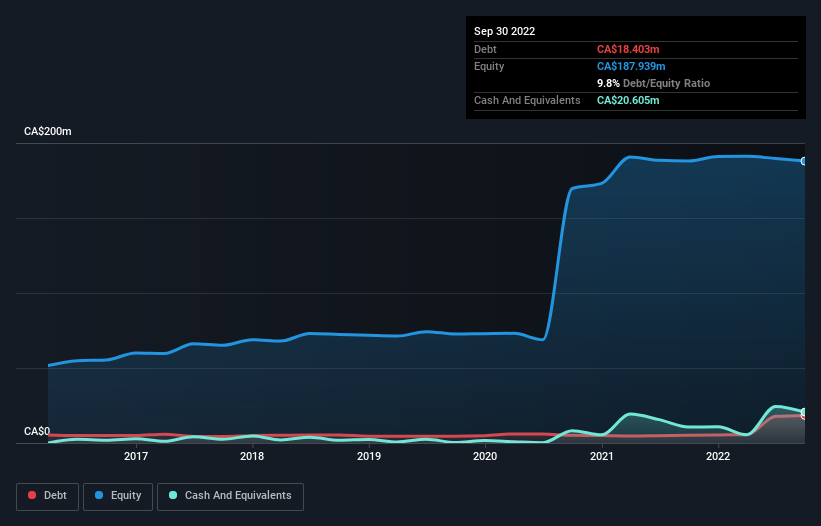Some say volatility, rather than debt, is the best way to think about risk as an investor, but Warren Buffett famously said that 'Volatility is far from synonymous with risk.' So it might be obvious that you need to consider debt, when you think about how risky any given stock is, because too much debt can sink a company. Importantly, Treasury Metals Inc. (TSE:TML) does carry debt. But is this debt a concern to shareholders?
What Risk Does Debt Bring?
Generally speaking, debt only becomes a real problem when a company can't easily pay it off, either by raising capital or with its own cash flow. Part and parcel of capitalism is the process of 'creative destruction' where failed businesses are mercilessly liquidated by their bankers. However, a more frequent (but still costly) occurrence is where a company must issue shares at bargain-basement prices, permanently diluting shareholders, just to shore up its balance sheet. Having said that, the most common situation is where a company manages its debt reasonably well - and to its own advantage. When we examine debt levels, we first consider both cash and debt levels, together.
See our latest analysis for Treasury Metals
How Much Debt Does Treasury Metals Carry?
As you can see below, at the end of September 2022, Treasury Metals had CA$18.4m of debt, up from CA$5.23m a year ago. Click the image for more detail. But on the other hand it also has CA$20.6m in cash, leading to a CA$2.20m net cash position.

How Strong Is Treasury Metals' Balance Sheet?
The latest balance sheet data shows that Treasury Metals had liabilities of CA$9.38m due within a year, and liabilities of CA$12.2m falling due after that. Offsetting this, it had CA$20.6m in cash and CA$373.0k in receivables that were due within 12 months. So it has liabilities totalling CA$582.6k more than its cash and near-term receivables, combined.
Having regard to Treasury Metals' size, it seems that its liquid assets are well balanced with its total liabilities. So it's very unlikely that the CA$44.2m company is short on cash, but still worth keeping an eye on the balance sheet. While it does have liabilities worth noting, Treasury Metals also has more cash than debt, so we're pretty confident it can manage its debt safely. When analysing debt levels, the balance sheet is the obvious place to start. But ultimately the future profitability of the business will decide if Treasury Metals can strengthen its balance sheet over time. So if you want to see what the professionals think, you might find this free report on analyst profit forecasts to be interesting.
Since Treasury Metals has no significant operating revenue, shareholders probably hope it will develop a valuable new mine before too long.
So How Risky Is Treasury Metals?
Although Treasury Metals had an earnings before interest and tax (EBIT) loss over the last twelve months, it generated positive free cash flow of CA$3.9m. So taking that on face value, and considering the net cash situation, we don't think that the stock is too risky in the near term. Until we see some positive EBIT, we're a bit cautious of the stock, not least because of the rather modest revenue growth. When analysing debt levels, the balance sheet is the obvious place to start. But ultimately, every company can contain risks that exist outside of the balance sheet. These risks can be hard to spot. Every company has them, and we've spotted 3 warning signs for Treasury Metals (of which 2 are a bit unpleasant!) you should know about.
At the end of the day, it's often better to focus on companies that are free from net debt. You can access our special list of such companies (all with a track record of profit growth). It's free.
Valuation is complex, but we're here to simplify it.
Discover if NeXGold Mining might be undervalued or overvalued with our detailed analysis, featuring fair value estimates, potential risks, dividends, insider trades, and its financial condition.
Access Free AnalysisHave feedback on this article? Concerned about the content? Get in touch with us directly. Alternatively, email editorial-team (at) simplywallst.com.
This article by Simply Wall St is general in nature. We provide commentary based on historical data and analyst forecasts only using an unbiased methodology and our articles are not intended to be financial advice. It does not constitute a recommendation to buy or sell any stock, and does not take account of your objectives, or your financial situation. We aim to bring you long-term focused analysis driven by fundamental data. Note that our analysis may not factor in the latest price-sensitive company announcements or qualitative material. Simply Wall St has no position in any stocks mentioned.
About TSXV:NEXG
NeXGold Mining
Operates as a gold exploration and development company in Canada.
Excellent balance sheet and fair value.
Market Insights
Community Narratives


Recently Updated Narratives


MINISO's fair value is projected at 26.69 with an anticipated PE ratio shift of 20x


Fiverr International will transform the freelance industry with AI-powered growth

Constellation Energy Dividends and Growth
Popular Narratives


MicroVision will explode future revenue by 380.37% with a vision towards success


NVDA: Expanding AI Demand Will Drive Major Data Center Investments Through 2026



